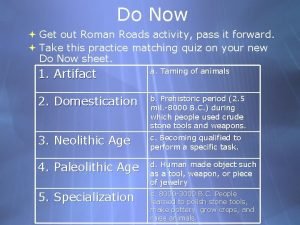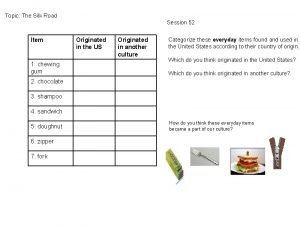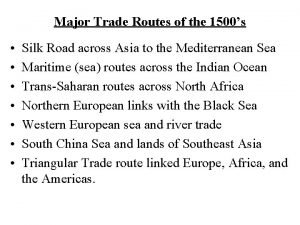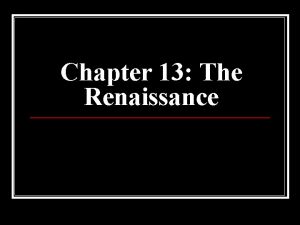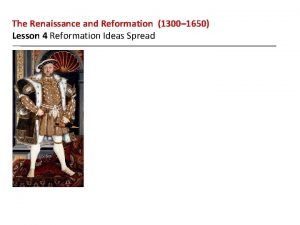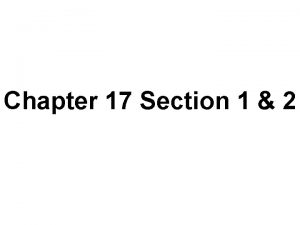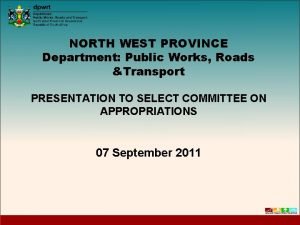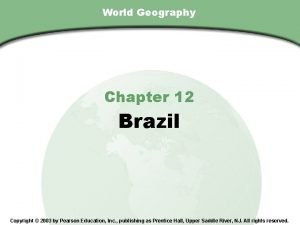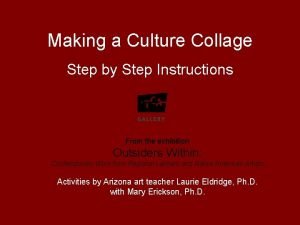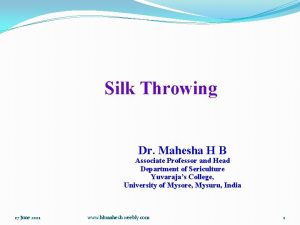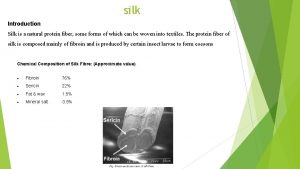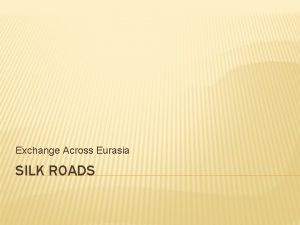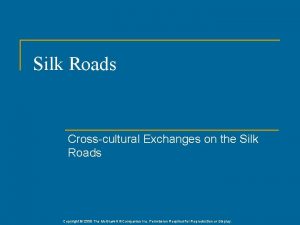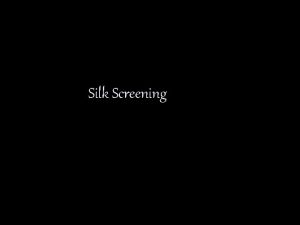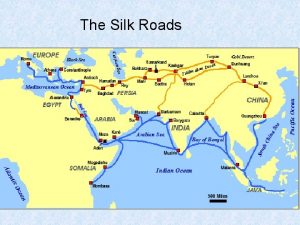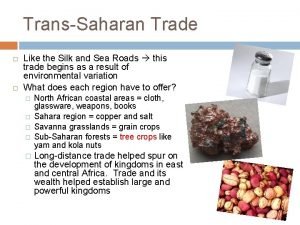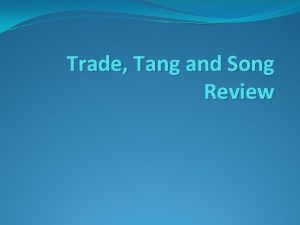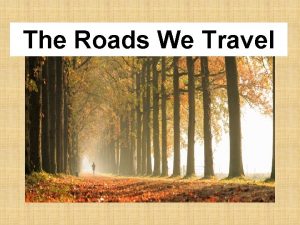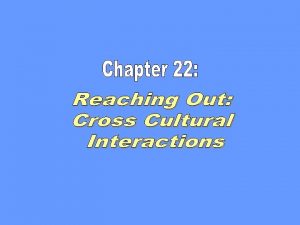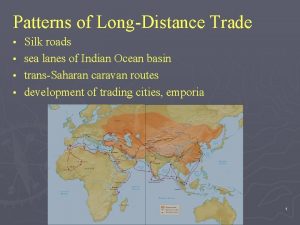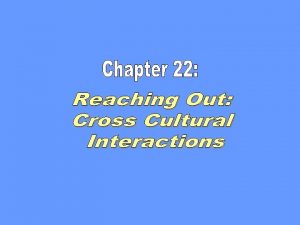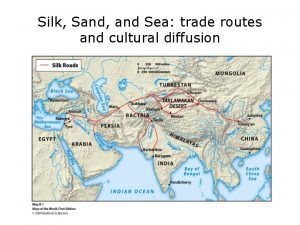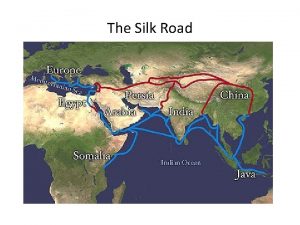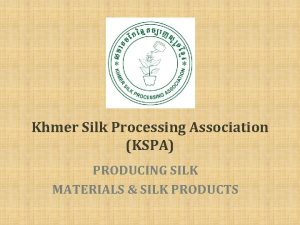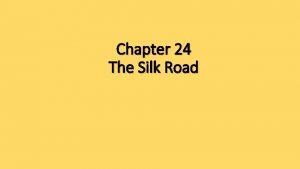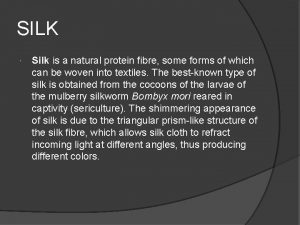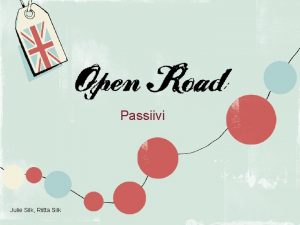Silk Roads Trade and Travel Spread Cultural Ideas
























- Slides: 24

Silk Roads: Trade and Travel Spread Cultural Ideas PART 1 - Background Carol Gersmehl, carol. gersmehl@gmail. com Co-coordinator, New York Geographic Alliance Power. Point prepared in cooperation with Marty Mater, Michigan Geographic Alliance Adapted with permission by Maggie Legates, Delaware Geographic Alliance, 2012

Silk Roads – Geographic Objectives Students will able to: Ø 1. Locate regions that were part of the Silk Road network (Mediterranean, Arabia, eastern Africa, Persia, Central Asia, India, and China) in 100 CE Ø 2. Describe physical conditions (deserts, mountains, rivers) at various places along the Silk Road. Ø 3. Identify important economic goods and cultural ideas (highly valued in 100 CE) that moved along the Silk Road. Ø 4. Explain how trade and travel along the Silk Road changed places over time.

Silk Roads - Vocabulary Merchant Monk Bandit --------------------------------Silk cloth Glass Spices Heavenly horses Ivory Cotton cloth --------------------------------Buddhism Islam --------------------------------Caravan Bactrian camel Dromedary camel --------------------------------Oasis Port city

Silk Roads - Resources This lesson is based on content found in The Silk Route, 7000 Miles of History by John S. Major Other books for children: -- We’re Riding on a Caravan, An Adventure on the Silk Road by Laurie Krebs -- Stories from the Silk Road by Cherry Gilchrist -- Caravan to America, Living Arts of the Silk Road by John S. Major & Betty J. Belanus (and forward by Yo-Yo Ma)

Facts about the trade network known as “The Silk Road” • It was more than one road - actually a network of caravan routes that stretched across the continent. • Developed over time by many traders and groups. • Almost no one traveled the whole route. Most people bought and sold goods on either end of one segment of the route.

Animals Camels, horses, and _______

People Bandits and Monks

Places Mountains, Deserts, Oases (plural of oasis)

Silk Road towns connected the largest cities of the West and East in 100 CE. West East

Students may use this map to see Silk Roads towns between China and the Mediterranean Sea. West East

Our Silk Roads journey starts in China. Between Chang’an (#1) and Dunhuang (#4): Bandits from Mongolia or Tibet may attack caravans. Therefore, Chinese soldiers must travel with the caravans. In the Chinese city of Chang’an (#1), merchants load fine silk cloth and herbal medicines onto two-humped Bactrian camels.

We will explore the Silk Roads using a satellite image. Find dry areas near the numbered Silk Road towns. Which colors indicate drier areas or deserts? tan In this satellite image, the green color tells us about vegetation. Green areas have enough water for trees and crops.

Dunhuang (#4) is an important Buddhist religious center. Buddhist monks traveled along the Silk Road and brought Buddhism from India to China.

Taklamakan Desert (“if you go in, you won’t come out”): Caravans must travel through this desert before the heat of summer hits. Find #5, #6, #7, #8, #9.

Rivers carry melted snow down from high mountains! High, snow-covered mountains surround the Taklamakan. Oasis towns are located along the edge of the Taklamakan Desert.

Kashgar (#10) is an oasis town, where local merchants trade their dates, melons, and grapes for silk that the caravans bring from China. Why did the Chinese travel this far west (to Central Asia)? Pamir Mountains (between #10 and #13): The route continues through mountains and is called the “Trail of Bones” because the route is dangerously steep and cold.

Pamir Mountains: Between Kashgar (#10) and Tashkent (#13), caravans climbed the “Trail of Bones” through the high, steep Pamirs. Pamir Mountains: Elevations are above 10, 000 feet. It is extremely cold, and there is no food. The highest elevations are purple and dark gray.

Why cross the Pamirs? The highest elevations are purple and dark gray.

In Tashkent (#13), Chinese military use silk to purchase the strong horses raised in the grasslands of Central Asia. In Tashkent (#13), local merchants also sell fine locally made wool carpets as well as musical instruments and glass objects that have come from Europe and the Middle East.

Dromedary camels from Arabia are used from here westward. #20 and #21 send In Herat (#17), a great Islamic mosque stands near the city market. People from Arabia brought the religion of Islam to Silk Road towns. spices and cotton cloth from India and precious stones from Ceylon.

Tyre (#27): Goods are loaded onto ships in this port city on the Mediterranean Sea. In Baghdad (#24), In Byzantium (#28), few people know where China is, but wealthy people want the silk that has traveled along the Silk Roads. ivory, gold, and spices from Africa and pearls from the Persian Gulf are exchanged for silk.

Silk Road towns connected the largest cities of the West and East in 100 CE.

Silk Road towns connected the largest cities of the West and East in 800 CE.

Thanks to all of our collaborators! New York Geographic Alliance Michigan Geographic Alliance Carol Gersmehl, carol. gersmehl@gmail. com Co-coordinator, New York Geographic Alliance Power. Point prepared in cooperation with Marty Mater, Michigan Geographic Alliance
 Modern roads vs roman roads venn diagram
Modern roads vs roman roads venn diagram Silk road trade route
Silk road trade route Trade routes 1500
Trade routes 1500 Lesson 1 the italian renaissance
Lesson 1 the italian renaissance How did enlightenment ideas spread
How did enlightenment ideas spread Renaissance spread map
Renaissance spread map What renaissance invention aided the spread of ideas?
What renaissance invention aided the spread of ideas? Trade diversion and trade creation
Trade diversion and trade creation Trade diversion and trade creation
Trade diversion and trade creation Trade diversion and trade creation
Trade diversion and trade creation Trade diversion and trade creation
Trade diversion and trade creation Tramp and liner shipping
Tramp and liner shipping Woollen textile industries
Woollen textile industries The trade in the trade-to-gdp ratio
The trade in the trade-to-gdp ratio Fair trade not free trade
Fair trade not free trade Ted talk slave trade
Ted talk slave trade Department of public works and roads rustenburg
Department of public works and roads rustenburg How did land grants and new roads affect brazil?
How did land grants and new roads affect brazil? Culture collage project
Culture collage project Ideas have consequences bad ideas have victims
Ideas have consequences bad ideas have victims Que son las ideas complementarias
Que son las ideas complementarias Goods traded on the silk road
Goods traded on the silk road Throwing process of silk
Throwing process of silk Silk is a natural protein fiber some forms of which can be
Silk is a natural protein fiber some forms of which can be Where does silk come from
Where does silk come from
